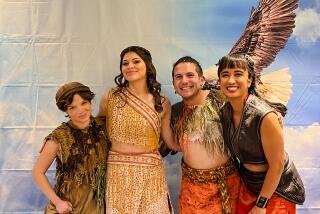Allison Williams in ‘Peter Pan’ continues a cross-dressing tradition
- Share via
As the lyrics go, Peter Pan is the boy who won’t grow up, won’t wear a tie and is never, ever gonna be a man. The stage musical version of J.M. Barrie’s story has traditionally made Peter’s refusal literal by casting a grown woman in drag to play theater’s most famous obstinate boy.
When embodied by a woman, many of whom have been middle-aged, Peter speaks the truth when he refuses to grow a mustache or a fraction of an inch.
On Wednesday, NBC announced that its live broadcast of “Peter Pan” will star Allison Williams, a young actress whose short career has so far included a role in the HBO series “Girls.” (She also happens to be the daughter of “NBC Nightly News” anchor Brian Williams.)
The live broadcast is scheduled for Dec. 4, and will star the previously announced Christopher Walken as Captain Hook.
Williams will follow in the cross-dressing footsteps of Mary Martin, Sandy Duncan and Cathy Rigby -- all of whom have played Peter on Broadway. Martin also starred in a televised version of the musical that aired on NBC in 1960 and later became a TV classic.
Even nonmusical stage versions of the “Peter Pan” story have cast women in the title role. Some past Broadway productions have starred Eva Le Gallienne, Jean Arthur and Maude Adams as the bratty, airborne protagonist.
The trouser (or transvestite) role of Peter Pan has historically been a practical imperative -- the character requires acting ability that is far beyond that of most preteen stage actors. But the casting also adds (deliberately or not) sexual subtext that carries echoes of Baroque opera and certain themes of Shakespearean comedy.
Operas by Monteverdi and other Baroque composers often feature roles written for castrati -- male opera singers who were castrated at a young age to preserve their boy voices. In contemporary productions, these male roles are typically played by female singers, usually mezzo-sopranos.
The gender-bending casting can sometimes result in love duets being performed by two women. (The most famous example is “Pur ti miro” from Monteverdi’s “The Coronation of Poppea.”) The lesbian overtones in these duets are never stated, though some directors of modern productions have made the subtext more explicit.
A similar dynamic can also be found in certain Shakespearean comedies that feature female characters assuming the guise of men -- and earning the misguided affections of another female character in the process.
In “As You Like It,” the heroine Rosalind takes the identity of Ganymede, a young man, to escape her authoritarian father. (“Pan” also features a young girl escaping her father.) In taking a male identity, Rosalind/Ganymede elicits the passion of the unsuspecting shepherdess Phebe.
“Peter Pan” doesn’t articulate the growing attraction between Peter and Wendy, and their friendship never crosses over to the romantic. But some productions have interpreted the story to represent Wendy’s first true love.
As noted by some Shakespeare scholars, there’s nothing more attractive to a girl than another girl dressed as a man.
Twitter: @DavidNgLAT
More to Read
The biggest entertainment stories
Get our big stories about Hollywood, film, television, music, arts, culture and more right in your inbox as soon as they publish.
You may occasionally receive promotional content from the Los Angeles Times.











